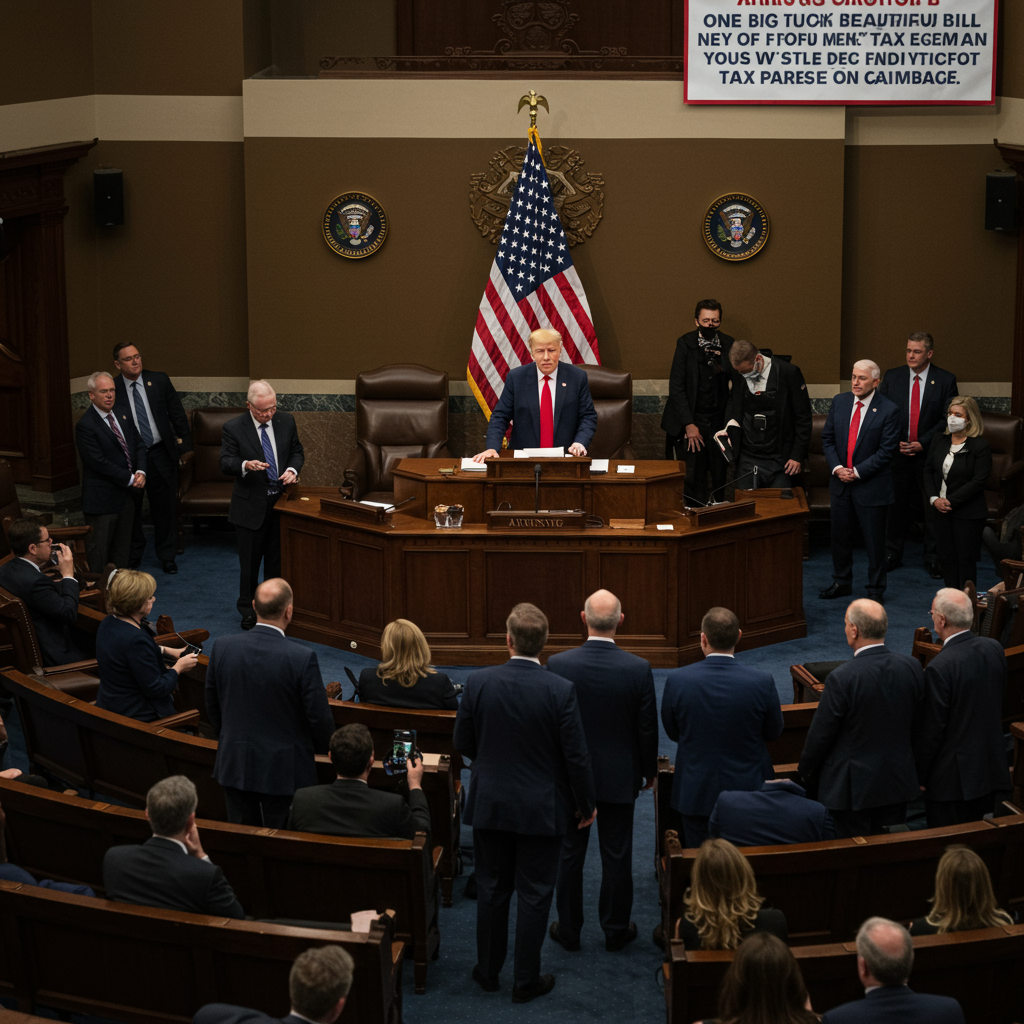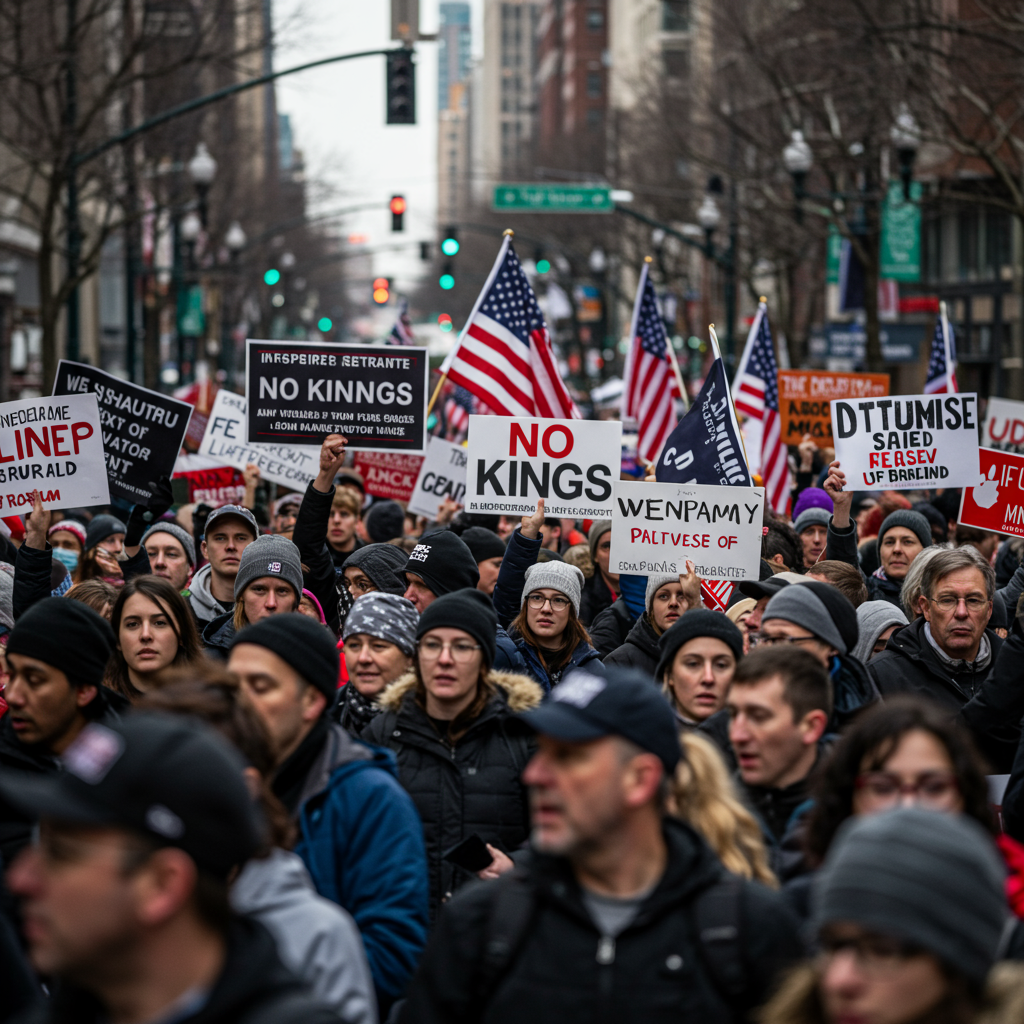The United States senate is locked in a fierce political struggle. Lawmakers are nearing a pivotal vote on a massive tax and spending bill proposed by former President Donald Trump. Trump himself has labeled the package his “One Big, Beautiful Bill.” It stands as a central piece of his potential second-term agenda. Passing this legislation is a key goal for Senate Republicans. The bill has moved past early procedural steps. However, it faces significant opposition even within the Republican party. Key senators are holding out, making final passage difficult. The intense debate involves complex procedures and sharp political disagreements. High stakes surround this sweeping proposal.
The “Big, Beautiful” Bill: What’s Inside?
At its core, this proposed bill is a massive legislative undertaking. It touches many parts of federal policy. these range from individual taxes to government spending and social programs.
Sweeping Tax Overhauls
A major part involves extending the large tax cuts from 2017. These cuts are set to expire soon. The Senate version adds temporary deductions for tip wages, up to $25,000. It also includes temporary deductions for overtime pay, up to $12,500. These benefits would disappear for people with higher incomes. The child tax credit would increase to $2,200. This amount would adjust for inflation after 2025. The standard deduction would become permanently larger. This offers tax relief to more people. A tax deduction for seniors over 65 would also temporarily increase. The bill includes about $4 trillion in tax cuts overall. This is mostly due to extending the 2017 provisions. A politically sensitive part is temporarily raising the cap on State and Local Tax (SALT) deductions. This is seen as vital to get support from Republicans in high-tax states.
Major Spending & Debt Hike
The legislation sets aside large amounts of money for specific areas. These include border security, national defense, and energy production. Billions are allocated for construction along the border. Funds will also go to facility upgrades and wider security efforts. A major part of the proposal is raising the nation’s debt limit by $5 trillion. This step is needed for the government to pay its bills. Without it, the U.S. could default on its debt. Economists warn this would have terrible results.
Contentious Safety Net Reforms
Controversially, the bill proposes big changes to social safety net programs. It includes reforms for the Supplemental Nutrition Assistance Program (SNAP). These expand work requirements for certain able-bodied adults. They could also change how states contribute to the program’s costs. For Medicaid, the joint federal-state healthcare program, the bill adds work requirements for many adult recipients. It also limits the taxes states can place on healthcare providers. Critics argue these changes could hurt millions of low-income Americans. Addressing some concerns, the Senate draft includes a dedicated fund. It provides billions over several years for rural hospitals.
Other Policy Shifts
Beyond taxes and safety nets, the bill addresses other policy areas. It revamps federal student loan programs. Existing repayment plans would be replaced. Loan limits for parents and graduate students would be capped. In technology, it provides funding for broadband development. It specifically allows this money for AI projects. Notably, states would be barred from regulating AI for a decade to get these funds. The bill also suggests new or higher fees for certain immigration services.
Navigating the Contentious Senate Path
The “One Big, Beautiful Bill” has faced a challenging journey through the Senate. It’s been marked by tough talks, procedural obstacles, and political maneuvering.
From Hurdles to “Vote-a-Rama”
The bill narrowly passed a key procedural vote. It advanced to debate despite two Republican senators opposing it. The release of the nearly 1,000-page bill text just before a weekend vote put pressure on lawmakers. They needed to act quickly to meet a self-imposed July 4th deadline. Senate Democrats wanted to slow the process. They also aimed to highlight their concerns. They forced the entire 940-page bill to be read aloud on the Senate floor. This took nearly 16 hours. This action started the clock for extensive debate. It also led to the upcoming “vote-a-rama.” This period allows senators to offer countless amendments and force votes on them.
Amendments and Political Warfare
The vote-a-rama has become a major battleground for both parties. Democrats are using it to force votes on controversial parts of the bill. They focus on potential cuts to healthcare, effects on rural hospitals, Medicaid eligibility, and food aid. Their goal is to make Republicans take public stances before elections. Many Democratic amendments have failed, usually along party lines. Republicans have also proposed changes. These include amendments on issues like Medicaid payments for undocumented immigrants or potential cuts to the federal Medicaid expansion match. A key fight occurred over how the bill’s cost is measured. Senate Majority Leader John Thune pushed for a “current policy baseline.” Democrats called this a “nuclear option.” They argued it made extending current tax cuts look less expensive. The Senate ultimately voted along party lines to use this method.
Political Fault Lines and Key Players
Passing major laws is tough in a closely divided Senate. This bill proves that.
The Reconciliation Advantage & GOP Math
The bill is moving forward using the budget reconciliation process. This special rule lets bills about spending, revenue, and debt pass with a simple majority. That means only 51 votes are needed, potentially with the Vice President breaking a tie. This avoids the usual 60 votes needed to stop a filibuster. Republicans have a 53-seat majority. Using reconciliation means they only need Republican support. They can pass it without Democratic votes. Vice President JD Vance has been present to cast a tie-breaking vote if required. Getting the needed votes has involved much negotiation. Last-minute changes were made to the bill text.
Vocal Opponents and Their Concerns
Most Republicans backed the first procedural vote after getting assurances. However, final passage is still uncertain. A few senators remain vocal holdouts. Senators Rand Paul and Thom Tillis openly opposed the bill’s advancement. They are expected to vote against it in the end. Senator Paul opposes raising the national debt limit. Senator Tillis has major concerns about possible Medicaid funding cuts. He argues these could cost his state billions. He says this goes against presidential promises. Even some moderate Republicans who supported the first vote are unsure about the final version. Senator Susan Collins, for example, said her ‘yes’ vote was just to allow debate. She is unhappy with proposed healthcare cuts and rural hospital funding.
White House Push vs. Fierce Opposition
The White House is heavily involved. President Trump is reportedly talking directly with lawmakers. White House officials publicly stress the bill’s importance. Press Secretary Karoline Leavitt stated the President is “adamant” it passes. She urged Republican unity. Democrats remain strongly against the bill. Senate Minority Leader Chuck Schumer calls it “radical.” Senator Patty Murray says its healthcare parts could be the “largest healthcare cuts in history.” Critics outside politics have also spoken out. Elon Musk raised concerns about economic effects. He also mentioned potential taxes on renewable energy projects from earlier drafts.
Fiscal Stakes: Deficit and Impact Concerns
A main criticism of the bill is its likely effect on the federal deficit. The non-partisan Congressional Budget Office (CBO) estimates are stark. They project the bill would increase the national debt by almost $3.3 trillion over ten years. The CBO also analyzed the healthcare changes. Their report estimates the proposed cuts could leave 7.8 million people uninsured. These numbers give strong support to critics. They warn about the bill’s long-term financial health impact. They also highlight its effects on vulnerable groups.
External Critiques: Musk, Brookings, and More
Prominent voices beyond Congress share these concerns. Elon Musk has strongly criticized the bill. He called it “political suicide” and a “disgusting abomination.” He argues it threatens future industries like green energy and technology. He believes it favors old, established sectors. Musk predicts job losses and slower innovation. This, he says, creates long-term economic problems. He sees the short-term boost as risking huge national debt. He even used the term “debt slavery” for future generations. This aligns with analyses suggesting limited long-term benefits, including perspectives mentioned in reports referencing the Brookings Institution. Musk specifically worries that directing resources to traditional areas hurts new sectors like electric vehicles and aerospace. These are key to his companies, Tesla and SpaceX. He fears this could harm the U.S. in global tech competition. His criticism puts pressure on Republican leaders. It has also strained his relationship with Trump and the GOP. While the White House hasn’t directly responded to his latest remarks, they maintain the bill helps the U.S. economy and finances.
What Lies Ahead for the Bill
The Senate is still holding marathon votes on amendments. The final outcome for the “Big, Beautiful Bill” is unclear. If the Senate passes it, it must be merged with the version passed by the House. The House also has a slim Republican majority. Some House members have concerns about changes made in the Senate. Bridging the differences between the two chambers adds more complexity. It creates more uncertainty in the timeline. All this happens under the pressure of the July 4th target date.
Frequently Asked Questions
What are the main tax changes included in the proposed Trump bill?
The bill makes several big changes to taxes for individuals. Its primary goal is extending the tax cuts from 2017. It temporarily adds new deductions for tip income, up to $25,000, and overtime pay, up to $12,500, though these disappear for higher earners. The child tax credit is set to rise to $2,200, adjusted for inflation after 2025. The standard deduction becomes permanently larger. Seniors over 65 also get a temporary increase in their deduction. For people in high-tax states, the cap on the State and Local Tax (SALT) deduction is temporarily raised.
Why is this bill controversial, especially regarding healthcare and social programs?
Critics have major concerns about the bill’s impact. The Congressional Budget Office (CBO) estimates it adds $3.3 trillion to the national debt over a decade. Regarding healthcare, the proposed cuts to Medicaid and new work requirements are particularly controversial. The CBO estimates these changes could result in 7.8 million Americans losing their health insurance. Senators like Thom Tillis worry their states could lose billions in healthcare funding. Opponents also argue the bill unfairly balances extending tax cuts that largely help the wealthy while reducing support for programs like Medicaid and SNAP that aid lower-income families.
How does the budget reconciliation process impact the bill’s chances of passing the Senate?
The budget reconciliation process is crucial for this bill. It allows certain legislation on spending, revenues, and the national debt to pass the Senate with a simple majority vote (51 votes). This is different from the typical 60 votes needed to overcome a filibuster. Because Republicans hold a 53-seat majority, using reconciliation means they theoretically only need votes from their own party members (or the Vice President in a tie). This lets them avoid needing any support from Democrats, who are strongly opposed to the bill’s contents.
Conclusion
The effort to pass President Trump’s “One Big, Beautiful Bill” is a major legislative fight. It carries deep consequences for U.S. tax policy, government spending, and social support programs. The Senate is going through a tough process of reviewing amendments and trying to find the final votes. The divisions within the Republican party and the strong opposition from Democrats highlight how contentious the bill is. With a narrow path to passage and key senators voicing serious concerns, the bill’s final outcome remains uncertain. It stands at a critical moment for the policy goals it aims to achieve.
Word Count Check: 1190



